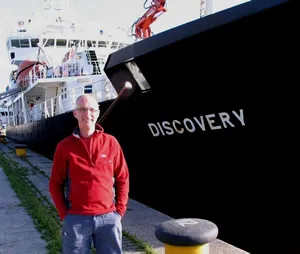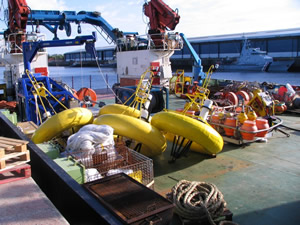
A research cruise to the Celtic Sea sails on Wednesday 2 June 2010. The Celtic Sea is located in the North Atlantic Ocean between southern Ireland and southwest England (between approximately 48° and 51.5°N latitude and 5° and 12°W longitude). Professor Jonathan Sharples of the National Oceanography Centre is on the cruise and will be writing a diary.
What is the cruise researching?
What happens to the growth of phytoplankton, the tiny, single-celled marine plants that are at the base of the ocean’s food chain, when a storm passes over the ocean?

In summer the sunlight warms the surface layer of the sea, leaving the deeper water much colder. In the warm surface layer there is lots of light, which the phytoplankton need to photosynthesise just like any other plant. But the nutrients that the phytoplankton need are in the colder, deeper water. The region between the cold and warm layers, the ‘thermocline’ where the water temperature changes rapidly, is very good at preventing the mixing of nutrients from the deep water towards the surface. However, a pulse of strong winds at the sea surface might add enough turbulence into the water to mix some deep nutrients through the thermocline and so to the phytoplankton.
We want to measure these wind-produced pulses of turbulence, see how they increase the supply of nutrients to the surface phytoplankton, and assess whether or not the phytoplankton respond (perhaps by growing more, or perhaps with some phytoplankton species doing better than others). So, we want some rough weather. A quick gale with calm weather before and after would be ideal, so that we have a good, clean nutrient mixing event with knowledge of what the phytoplankton were doing before, during and after.
Who is on board and what equipment is being using?
On board the ship we have scientists from the University of Liverpool and the National Oceanography Centre, from Bangor University, and from the University of Southampton. We will be using instruments and water samplers attached to moorings on the seabed, and other instruments which we lower or tow from the ship, measuring the fundamental turbulence, the mixing of different nutrients, and the growth rates of the different phytoplankton. Over the next few days I’ll focus on some of the different technologies that we are using and explain how they fit into the story.
Diary
On Wednesday 2 June we sail at 09:00 from the King George V dock outside Glasgow. The weather forecast looks calm for the next few days, which is good because it allows the phytoplankton to get used to the very low supply of nutrients. It’s also good as it will allow us to gain our sea-legs so that when the winds do pick up we should be used to the ship’s movement. Regular updates will be posted on the site about the science being undertaken and life on board a research ship.